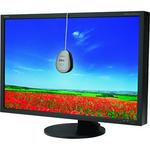

|


|

$200 Leica BP-SCL6 Lithium-Ion Battery (8.4V, 2200mAh) BACK IN STOCK in Accessories: Batteries and Power
|

|

|

|
Understanding Display Calibration: Real vs Faux Calibration
Related: color space and gamut, display, NEC PA302W, NEC professional displays
See also Web Browser Display of Image Color (Color Space).
Display calibration means bringing the display electronics as close as possible to a specified target state, e.g., 6200°K white balance at gamma 2.2 at some specified luminance is actually displayed exactly as expected. In other words, the device itself is brought into comformance with a desired behavior (color and brightness across the spectrum).
Contrast that with faux calibration (more on that below).
Once calibrated, a display profile is generated describing the actual display characteristics, which might vary slightly from the ideal calibration targe (delta E, see Color Tracking).
A high quality display has a profile that is nearly identical to the calibration target, deviating only trivially from what the display actually displays. A lower quality display might be incapable of displaying some colors accurately or have a non-linear behavior; its profile can compensate to some degree. Ideally, the calibration is perfect and thus the profile has no deviation from the ideal.
Let’s take a scale (weight) as a simple analogy: a scale that reads 998 grams for a 1000.00 gram weight is out of calibration. The scale can be adjusted (calibrated) to weigh 1000.00 grams as 1000.00 grams, or 382.43 g as 382.43 g, not 383.7 g (or something else). A good quality scale can be adjusted in this way to read the weight exactly (to the limit of its precision), but a lower quality scale will show errors. A scale that is consistently off can be “profiled” by keeping track of its behavior in reading high or low across its range (“reads 1% low up to 500g and 1% high over 500g”).
Faux calibration
The term “calibration” is abused: true calibration means bringing the hardware device (the display) to a specified target state. The actual behavior vs specified target is then measured, and a profile is generated that describes the differences.
With most so-called “calibration”, the display itself cannot and does not change. In short, it is not calibrated at all. Instead, 8-bit video card data is altered in an attempt to produce an image that approximates the proper intensity and color, using repeated measurements. This is impossible to do well in 8 bit, particularly in darker tones, where there are only a few bits to work with (not even 8 bits!). But even 8 bits is woefully inadequate, certainly so in a 3D color space.
Thus “calibrating” an Apple display or other brand is actually not calibration at all, but a laughably crude lipstick on a pig effort that is often worse than the stock Apple profile supplied by Apple. Whether the hardware calibration is done with a $100 or $5000 calibrator doesn’t matter: no actual calibration occurs (the display does not actually change other than perhaps contrast and brightness), Rather, 8 bits on the video card make some crude stepped approximation.
Update July 2016: if and when calibration software does faux calibration in 10 bits (4X the precision), the results should be far better and probably “good enough”. Still, it pales in comparison to true internal 14-bit calibration as with NEC displays.
Example
As shown below, the NEC Spectra View II software for the NEC wide gamut displays shows how close the display comes to the perfect calibration target curve—incredibly close.

The SpectraView II software also shows deviation from accuracy in “Delta E” terms across the brightness range. One Delta A is considered true professional grade accuracy.























